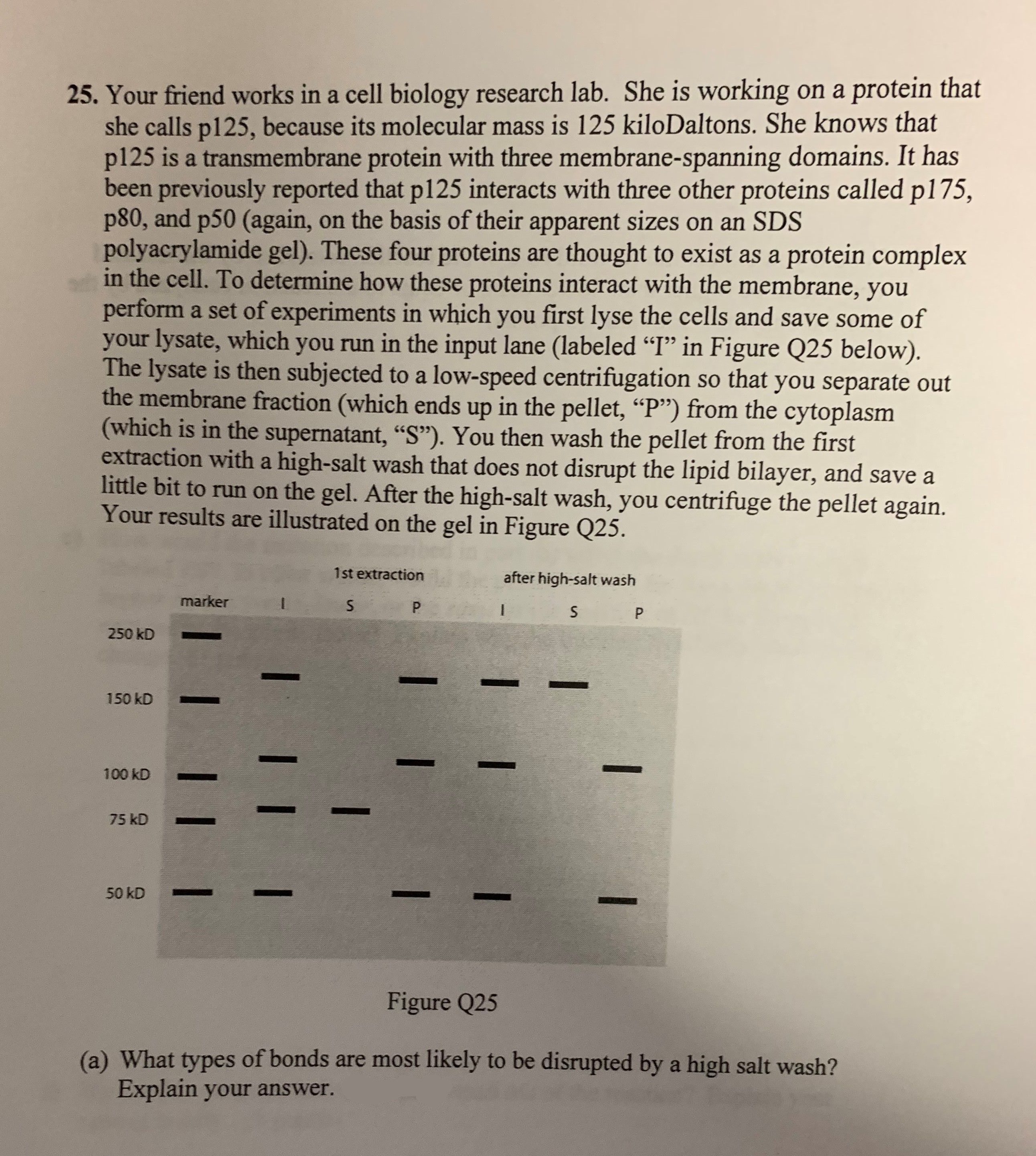
Human Anatomy & Physiology (11th Edition)
11th Edition
ISBN: 9780134580999
Author: Elaine N. Marieb, Katja N. Hoehn
Publisher: PEARSON
expand_more
expand_more
format_list_bulleted
Question
thumb_up100%

Transcribed Image Text:25. Your friend works in a cell biology research lab. She is working
she calls p125, because its molecular mass is 125 kiloDaltons. She knows that
p125 is a transmembrane protein with three membrane-spanning domains. It has
been previously reported that p125 interacts with three other proteins called p175,
p80, and p50 (again,
polyacrylamide gel). These four proteins
in the cell. To determine how these proteins interact with the membrane, you
perform a set of experiments in which you first lyse the cells and save some of
your lysate, which you run in the input lane (labeled "I" in Figure Q25 below).
The lysate is then subjected to a low-speed centrifugation so that you separate out
the membrane fraction (which ends up in the pellet, "P") from the cytoplasm
(which is in the supernatant, "S"). You then wash the pellet from the first
extraction with a high-salt wash that does not disrupt the lipid bilayer, and save a
little bit to run on the gel. After the high-salt wash, you centrifuge the pellet again.
Your results are illustrated on the gel in Figure Q25.
protein that
on a
on the basis of their apparent sizes on an SDS
thought to exist as a
protein complex
1st extraction
after high-salt wash
marker
S
P
P
250 kD
150 kD
100 kD
75 kD
50 kD
Figure Q25
(a) What types of bonds are most likely to be disrupted by a high salt wash?
Explain your answer.
I
I
1
I | |
Expert Solution
This question has been solved!
Explore an expertly crafted, step-by-step solution for a thorough understanding of key concepts.
This is a popular solution
Trending nowThis is a popular solution!
Step by stepSolved in 2 steps

Knowledge Booster
Similar questions
- Many transmembrane proteins have a large series of hydrophobic amino acids such as those in the middle of the protein (around b). Why would this make sense, and where would you expect these to be located in the final protein structure?arrow_forwardIf you did a classic Pulse-Chase experiment to follow the path of a secreted protein, and you forgot to do the Chase, which of the following would you observe? No radioactivity would be seen in any of the structures. Radioactivity would increase first in rough ER, then Golgi Complex, then secretory vesicles, but it would remain high in all, never decreasing. Nothing would change Radioactivity would increase in all 3 structures simultaneously and stay high.arrow_forward7arrow_forward
- : Yeast cells adapt to cold environments by and the length of the phospholipid tails the number of saturated fatty acid tails in the plasma membrane. Increasing....... Decreasing b. Decreasing....... Increasing C. Decreasing ....... Decreasing d. Increasing ....... Increasing Bacterial cells adapt to high temperatures by the length and the amount of saturated fatty acid tails in the plasma membrane. Increasing ...... Decreasing b. Decreasing....... Increasing C. Decreasing....... Decreasing d. Increasing....... Increasingarrow_forward1. The CFTR protein is a chloride channel in the cell membrane. Use your understanding of the biochemical properties/categories of amino acids and how they interact with membrane phospholipids to predict the distribution of charged/polar, and non-polar amino acids within the domains of CFTR listed below. Consider one category to include the charged amino acids and the polar amino acids and the other category to include the non-polar amino acids. For each domain, predict which category of amino acids is likely to be most abundant. Also, explain the rationale behind your prediction. Protein domain Prediction (Charged/Polar or Non-Polar amino acids?) Explanation for prediction TMD1 and TMD2 (transmembrane domains, parts 1-12) ECLs and ICLs (extracellular and intracellular loops) NBD1 and NBD2 Rarrow_forwardThe role of GTP hydrolysis in actin polymerization is similar to the role of ATP hydrolysis in tubulin polymerization: both serve to weaken the bonds in the polymer and thereby promote depolymerization. Is that true or false? why?arrow_forward
arrow_back_ios
arrow_forward_ios
Recommended textbooks for you
 Human Anatomy & Physiology (11th Edition)BiologyISBN:9780134580999Author:Elaine N. Marieb, Katja N. HoehnPublisher:PEARSON
Human Anatomy & Physiology (11th Edition)BiologyISBN:9780134580999Author:Elaine N. Marieb, Katja N. HoehnPublisher:PEARSON Biology 2eBiologyISBN:9781947172517Author:Matthew Douglas, Jung Choi, Mary Ann ClarkPublisher:OpenStax
Biology 2eBiologyISBN:9781947172517Author:Matthew Douglas, Jung Choi, Mary Ann ClarkPublisher:OpenStax Anatomy & PhysiologyBiologyISBN:9781259398629Author:McKinley, Michael P., O'loughlin, Valerie Dean, Bidle, Theresa StouterPublisher:Mcgraw Hill Education,
Anatomy & PhysiologyBiologyISBN:9781259398629Author:McKinley, Michael P., O'loughlin, Valerie Dean, Bidle, Theresa StouterPublisher:Mcgraw Hill Education, Molecular Biology of the Cell (Sixth Edition)BiologyISBN:9780815344322Author:Bruce Alberts, Alexander D. Johnson, Julian Lewis, David Morgan, Martin Raff, Keith Roberts, Peter WalterPublisher:W. W. Norton & Company
Molecular Biology of the Cell (Sixth Edition)BiologyISBN:9780815344322Author:Bruce Alberts, Alexander D. Johnson, Julian Lewis, David Morgan, Martin Raff, Keith Roberts, Peter WalterPublisher:W. W. Norton & Company Laboratory Manual For Human Anatomy & PhysiologyBiologyISBN:9781260159363Author:Martin, Terry R., Prentice-craver, CynthiaPublisher:McGraw-Hill Publishing Co.
Laboratory Manual For Human Anatomy & PhysiologyBiologyISBN:9781260159363Author:Martin, Terry R., Prentice-craver, CynthiaPublisher:McGraw-Hill Publishing Co. Inquiry Into Life (16th Edition)BiologyISBN:9781260231700Author:Sylvia S. Mader, Michael WindelspechtPublisher:McGraw Hill Education
Inquiry Into Life (16th Edition)BiologyISBN:9781260231700Author:Sylvia S. Mader, Michael WindelspechtPublisher:McGraw Hill Education

Human Anatomy & Physiology (11th Edition)
Biology
ISBN:9780134580999
Author:Elaine N. Marieb, Katja N. Hoehn
Publisher:PEARSON

Biology 2e
Biology
ISBN:9781947172517
Author:Matthew Douglas, Jung Choi, Mary Ann Clark
Publisher:OpenStax

Anatomy & Physiology
Biology
ISBN:9781259398629
Author:McKinley, Michael P., O'loughlin, Valerie Dean, Bidle, Theresa Stouter
Publisher:Mcgraw Hill Education,

Molecular Biology of the Cell (Sixth Edition)
Biology
ISBN:9780815344322
Author:Bruce Alberts, Alexander D. Johnson, Julian Lewis, David Morgan, Martin Raff, Keith Roberts, Peter Walter
Publisher:W. W. Norton & Company

Laboratory Manual For Human Anatomy & Physiology
Biology
ISBN:9781260159363
Author:Martin, Terry R., Prentice-craver, Cynthia
Publisher:McGraw-Hill Publishing Co.

Inquiry Into Life (16th Edition)
Biology
ISBN:9781260231700
Author:Sylvia S. Mader, Michael Windelspecht
Publisher:McGraw Hill Education